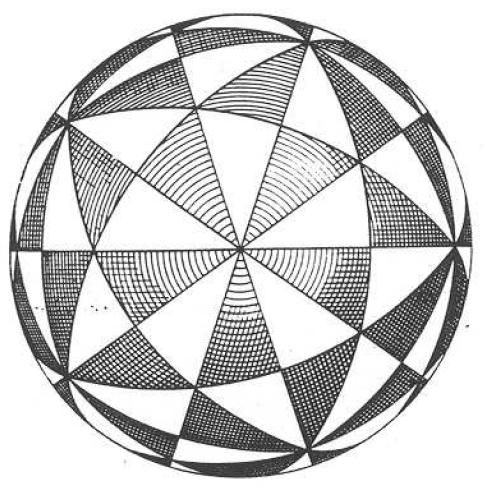Some time ago I was messing around and brewed up a cute little Wallis-type product for the golden ratio,
\[\begin{align*}\phi=\frac{2\cdot3}{1\cdot4}\cdot\frac{7\cdot8}{6\cdot9}\cdot\frac{12\cdot13}{11\cdot14}\cdot\frac{17\cdot18}{16\cdot19}\cdot\frac{22\cdot23}{21\cdot24}\cdots.\tag{1}\end{align*}\]At first glance this identity is pretty mundane, but there’s something very peculiar about it — all of the denominator terms are quadractic residues mod $5$ and all of the numerator terms are quadratic non-residues mod $5$. Perhaps a proof of this product will shed light on why this is happening.
Proof of (1): We can start with the fact that $2\cos\left(\frac{\pi}{5}\right)=\phi$, which implies $\frac{\sin\left(2\pi/5\right)}{\sin\left(\pi/5\right)}=\phi$. Applying Euler’s product for the sine yields
\[\begin{align*}\frac{\sin\left(\frac{2\pi}{5} \right )}{\sin\left(\frac{\pi}{5} \right )} &=\frac{\frac{2\pi}{5}\prod_{n=1}^\infty\left(1-\frac{(2\pi/5)^2}{n^2\pi^2} \right )}{\frac{\pi}{5}\prod_{n=1}^\infty\left(1-\frac{(\pi/5)^2}{n^2\pi^2} \right )} \\ &=2\prod_{n=1}^\infty\frac{(5n)^2-4}{(5n)^2-1} \\ &= 2\prod_{n=1}^\infty\frac{(5n+2)(5n-2)}{(5n+1)(5n-1)}\\ &= \prod_{n=0}^\infty\frac{(5n+2)(5n+3)}{(5n+1)(5n+4)}.\qquad\blacksquare\\\end{align*}\]Nice and easy, but no real insight into why this pattern occurs.
A class number formula
It was not until much later that I realized this product could be obtained through a special case of the Dirichlet class number formula. Let $\chi(n)=\left(\frac{d}{n}\right)$ where $\left(\frac{d}{n}\right)$ is the Kronecker symbol associated to a real quadratic field $\mathbb{Q}(\sqrt{d})$. Also suppose the shortest period of $\chi(n)$ is a prime $p\equiv1\,(\text{mod}\,4)$, then
\[\begin{align*}\sum_{n=1}^\infty\frac{\chi(n)}{n}=-\frac{1}{2\sqrt{p}}\sum_{n=1}^{p-1}\left(\frac{n}{p}\right)\ln\left(\sin\left(\frac{n\pi}{p}\right)\right).\tag{2}\end{align*}\]We also have
\[h(d)=\frac{\sqrt{d}}{\ln(\epsilon)}\sum_{n=1}^\infty\frac{\chi(n)}{n}\]where $h(d)$ is the class number of $\mathbb{Q}(\sqrt{d})$ and $\epsilon$ is the fundamental unit of the same field. Combing this with $(2)$ tells us that
\[\begin{align*}\frac{h(d)\ln(\epsilon)}{\sqrt{d}}=-\frac{1}{2\sqrt{p}}\sum_{n=1}^{p-1}\left(\frac{n}{p}\right)\ln\left(\sin\left(\frac{n\pi}{p}\right)\right).\end{align*}\]Now pick $d$ such that $h(d)=1$ and $p=d,$ then upon exponentiating the above we see that
\[\epsilon=\prod_{n=1}^{p-1}\left(\sin\left(\frac{n\pi}{p}\right)\right)^{-(n\,|\,p)/2}\]and if we make use of some basic symmetry of the sine function we get
\[\begin{align*}\epsilon=\prod_{n=1}^{(p-1)/2}\left(\sin\left(\frac{n\pi}{p}\right)\right)^{-(n\,|\,p)}.\tag{3}\end{align*}\]So now we see how the factors were distributed by residues!
Acquiring new products
Using $(3)$ in combination with $\sin(n\pi/p)=\Gamma(n/p)\Gamma(1-n/p)$ and
\[\prod_{m=1}^k\frac{\Gamma(1-b_m)}{\Gamma(1-a_m)}=\prod_{n=1}^\infty\prod_{m=1}^k\frac{n-a_m}{n-b_m}\]where $b_m\notin\mathbb{N}$ for all $m$ and $\sum_{m=1}^k(a_m-b_m)=0$ lets us quickly churn out a bunch of these products. As a quick note before we proceed, the fundamental unit, $\epsilon=\frac{x_0+y_0\sqrt{d}}{2}$, may be calculated by finding the smallest positive integer solution $(x_0,\,y_0)$ to $x^2-dy^2=\pm4.$ And we can easily pick out fields wth class number $1$ with any old table.
$\mathbb{Q}(\sqrt{5})$
In this field, when $d=5$, we have $p=5$, $h(5)=1$, and $\epsilon=\frac{1+\sqrt{5}}{2}$. Using these in $(3)$ produces $(1)$.
$\mathbb{Q}(\sqrt{13})$
Here we have $p=13$, $h(13)=1$, and $\epsilon=\frac{3+\sqrt{13}}{2}$ so
\[\frac{3+\sqrt{13}}{2}=\prod_{n=0}^\infty\frac{(13n+2)(13n+5)(13n+6)(13n+7)(13n+8)(13n+11)}{(13n+1)(13n+3)(13n+4)(13n+9)(13n+10)(13n+12)}.\]$\mathbb{Q}(\sqrt{29})$
Setting $d=29$ has $p=29$, $h(29)=1$, and $\epsilon=\frac{5+\sqrt{29}}{2}$ which leads us to the gargantuan product
\[\frac{5+\sqrt{29}}{2}=\prod_{n=0}^\infty\frac{(29n+2)(29n+3)(29n+8)(29n+10)(29n+11)(29n+12)(29n+14)(29n+15)(29n+17)(29n+18)(29n+19)(29n+21)(29n+26)(29n+27)}{(29n+1)(29n+4)(29n+5)(29n+6)(29n+7)(29n+9)(29n+13)(29n+16)(29n+20)(29n+22)(29n+23)(29n+24)(29n+25)(29n+28)}.\]And that will be the last one because things are starting to get hideous.
Algebraic gamma quotients
Another way to generalize this is by asking: when is a quotient of gamma functions algebraic? Playing around with the reflection formula, minimal polynomials, and some educated guesses gave the value
\[\frac{\Gamma\left(\frac{1}{24}\right)\Gamma\left(\frac{11}{24}\right)}{\Gamma\left(\frac{5}{24}\right)\Gamma\left(\frac{7}{24}\right)}=\sqrt{3}\sqrt{3+\sqrt{2}}\]which satisfies $x^4-12x^2+9=0$. Not to my surprise, this was already listed on Wolfram. Some browsing on stack exchange also turns up the remarkable identity
\[\frac{\Gamma\left(\frac{1}{21}\right)\Gamma\left(\frac{4}{21}\right)\Gamma\left(\frac{16}{21}\right)}{\Gamma\left(\frac{2}{21}\right)\Gamma\left(\frac{8}{21}\right)\Gamma\left(\frac{11}{21}\right)}=\sqrt[3]{14+3\sqrt{21}}\]conjectured by user Wolfgang and proven by pisco by making use of the Gauss multiplication formula for the gamma function. These idnetities may also be expanded out into the similar infinite products
\[\prod_{n=0}^\infty\frac{(24n+5)(24n+7)}{(24n+1)(24n+11)}=\sqrt{3}\sqrt{3+\sqrt{2}}\]and
\[\prod_{n=0}^\infty\frac{(21n+2)(21n+8)(21n+11)}{(21n+1)(21n+4)(21n+16)}=\sqrt[3]{14+3\sqrt{21}}.\]